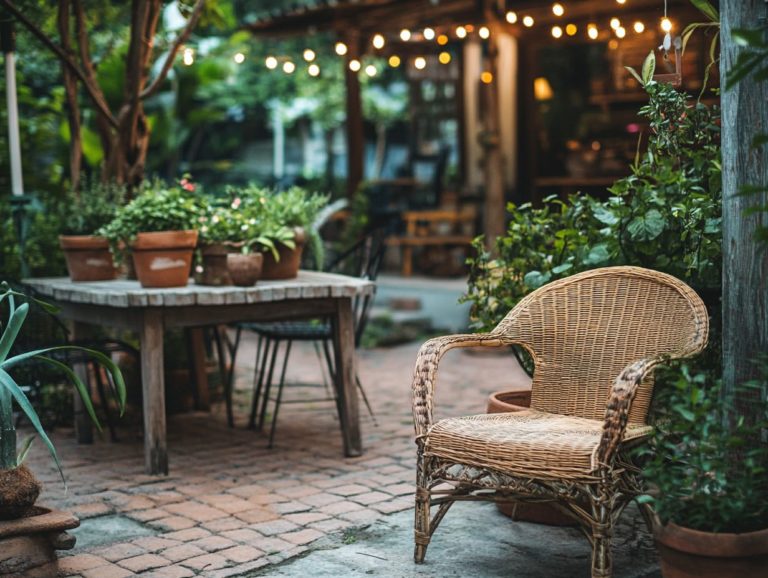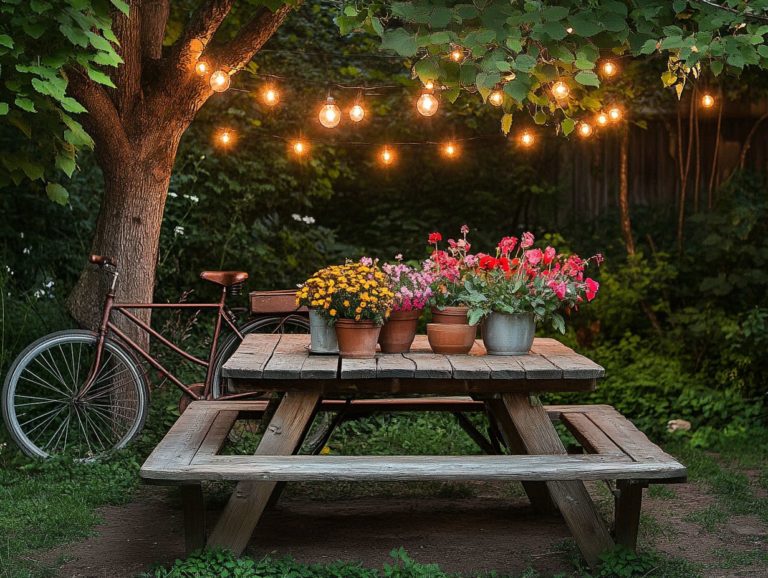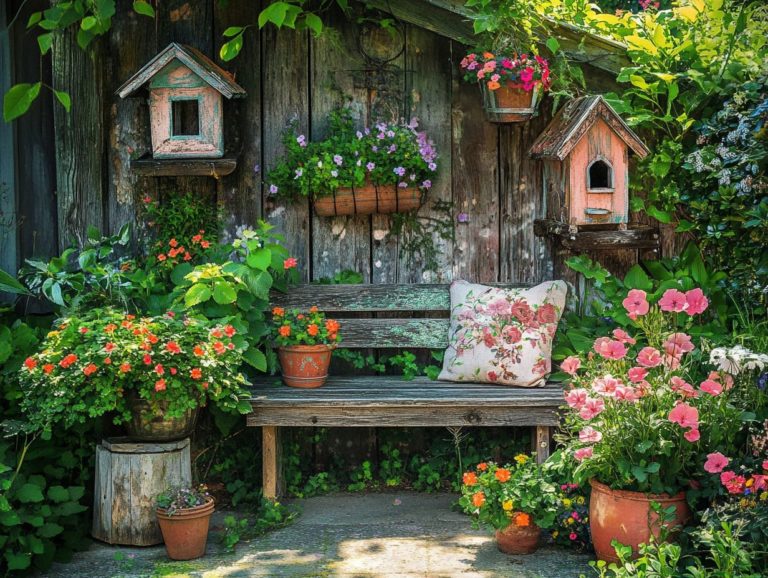5 Vintage Garden Arches to Elevate Your Landscape
Transforming your outdoor space can be effortlessly accomplished with the addition of a garden arch, serving as a charming entryway to your landscape.
These delightful structures not only serve as captivating focal points but also create enchanting pathways for your climbing plants, enhancing the overall beauty of your outdoor design.
Explore five stunning vintage garden arches, each exuding its own unique charm. They showcase a blend of rustic and elegant designs that can elevate any backyard. From timeless wooden designs to intricately wrought metal creations, you re bound to discover the perfect arch that enhances your landscape.
You will also find helpful tips on selecting the right arch, maintaining its beauty, and creative ideas to enhance your garden s allure, ensuring it serves as a durable support for your climbing plants.
Contents
- Key Takeaways:
- 1. Classic Wooden Garden Arch
- 2. Metal Garden Arch with Decorative Details
- 3. Rustic Stone Garden Arch
- 4. Wrought Iron Garden Arch with Intricate Design
- 5. Vintage Garden Arch with Climbing Plants
- How to Choose the Right Garden Arch for Your Landscape?
- Frequently Asked Questions
- 1. What are some popular styles of vintage garden arches, including arched and rustic designs?
- 2. How can a vintage garden arch elevate my landscape by enhancing the beauty and creating a focal point for climbing plants?
- 3. Are vintage garden arches durable, especially those made from metal or wood?
- 4. Can I customize a vintage garden arch to fit my specific landscape with unique design options?
- 5. How do I care for a vintage garden arch to ensure its longevity and support for climbing plants?
- 6. Are vintage garden arches difficult to install, or can they be a fun DIY project for homeowners?
Key Takeaways:
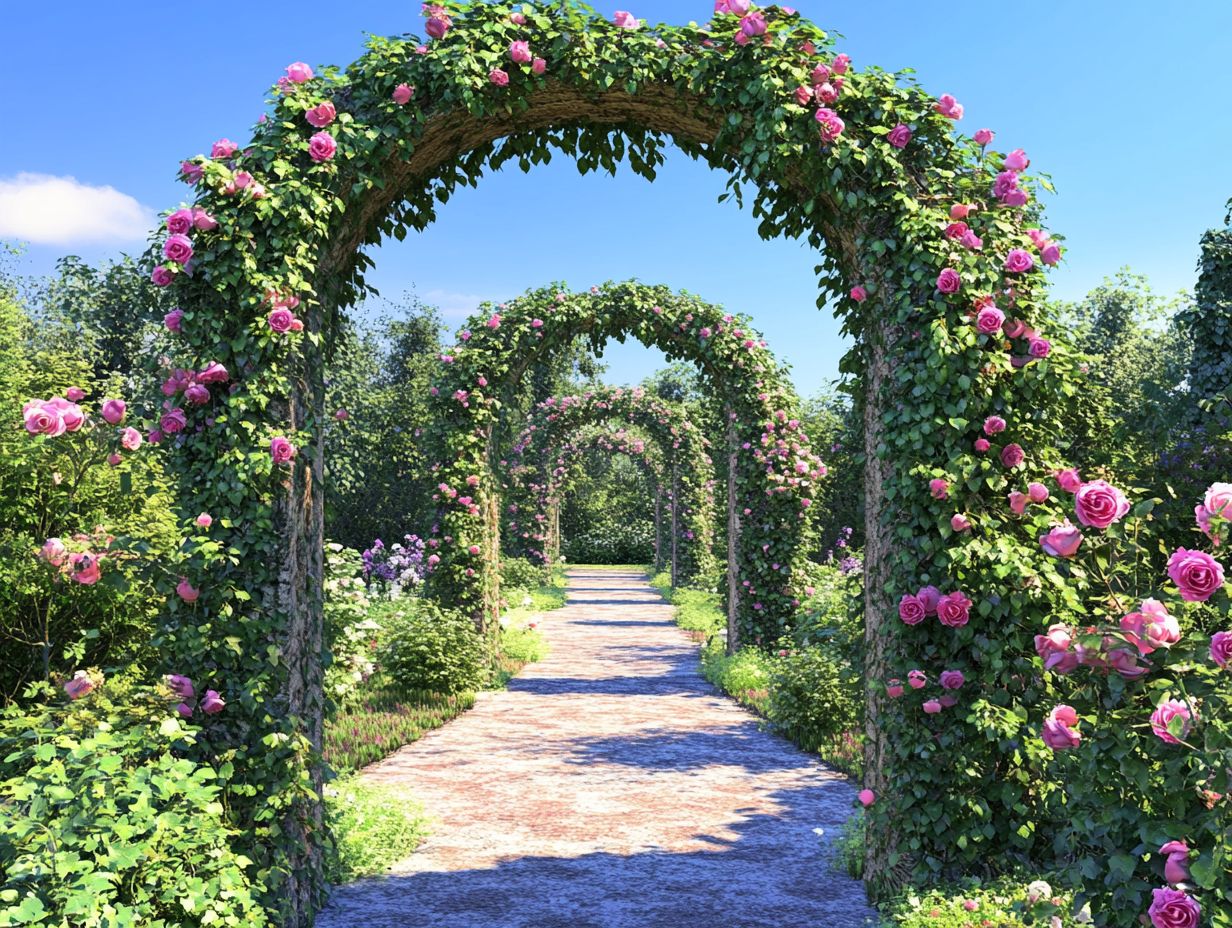
- Choose a garden arch that complements the style of your landscape, such as a classic wooden arch for a traditional look or a decorative metal arch with unique details for a more elaborate design.
- Consider the material, size, and placement of your garden arch to ensure it enhances the overall aesthetic of your space and provides the necessary support for climbing plants.
- Get creative with your garden arch by using it as a focal point or as support for climbing plants. Remember to regularly maintain it to keep it looking its best.
1. Classic Wooden Garden Arch
The classic wooden garden arch stands as a timeless structure that effortlessly combines functionality with aesthetic appeal. It serves as a captivating entryway to your outdoor space while providing essential support for climbing plants like wisteria and roses.
This enduring design adds charm and elegance to your landscape, creating a striking focal point in your backyard reminiscent of classic architecture.
Its rustic charm fits seamlessly into various garden styles, from cottage to contemporary, making it a versatile choice for any homeowner. The durability of high-quality wood ensures it withstands the elements, offering longevity without sacrificing beauty or structural integrity.
Perfect for supporting climbing plants such as clematis, honeysuckle, and jasmine, a wooden arch cultivates a lush environment that can transform an ordinary garden into a flourishing retreat.
When you install it, make sure to create a stable foundation anchored deep into the ground for the necessary support. Also, position it strategically to catch the sun, helping your climbing plants thrive beautifully.
2. Metal Garden Arch with Decorative Details
A metal garden arch, embellished with decorative details, can elevate the elegance and unique charm of your outdoor space. It serves as a stunning support structure for climbing plants, enhancing the visual allure of your landscape.
This captivating focal point can embrace various designs, from intricately wrought iron patterns a type of strong, durable iron used for decorative outdoor structures to sleek, modern interpretations featuring geometric shapes. Each style offers a distinct aesthetic that beautifully complements vibrant climbing plants like roses, clematis, and jasmine.
Metal arches not only exhibit remarkable durability, standing strong against the elements, but they also require minimal maintenance, allowing you to enjoy their beauty with ease.
For the best results, secure the arch in well-draining soil soil that allows water to flow through easily that provides ample support, ensuring both the structure and your climbing plants flourish together for years to come.
Don t miss out on transforming your garden explore your options today!
3. Rustic Stone Garden Arch
A rustic stone garden arch presents a captivating visual element that seamlessly marries natural beauty with enduring strength. This inviting outdoor structure not only supports an array of climbing plants but elevates your overall landscape design.
This enchanting addition draws the eye and acts as a focal point, infusing your garden with character through its organic texture and rich earth tones. When you incorporate such an arch, it s crucial to select stones that complement the surrounding flora while aligning with your desired aesthetic, whether you prefer the rugged charm of weathered granite or the gentle allure of softer sandstone.
Ensure a solid foundation for stability against the elements. Pairing this structure with vibrant climbers like wisteria or clematis can create a stunning tapestry of colors, providing seasonal interest and crafting a natural canopy that transforms your garden into a serene retreat.
4. Wrought Iron Garden Arch with Intricate Design

Imagine the beauty of a wrought iron garden arch, adorned with intricate design elements, becoming a striking architectural focal point in your outdoor space. It not only provides robust support for climbing plants but also elevates the elegance of your landscape.
The detailed scrollwork (decorative patterns usually made by twisting metal) and durable structure of these arches are sure to captivate attention, offering a classic look that harmonizes beautifully with various landscaping styles. You might choose to drape lush honeysuckle or vibrant clematis around the arch, crafting a breathtaking display that invites both beauty and tranquility.
Whether you place it within a formal garden, a cozy cottage-style setting, or a contemporary landscape, this arch has the power to transform your environment into a serene retreat. To enhance the visual appeal, consider planting flowers at the base or incorporating soft lighting that highlights the arch s graceful curves, turning it into a picturesque feature for nighttime enjoyment.
5. Vintage Garden Arch with Climbing Plants
Imagine a vintage garden arch, adorned with vibrant climbing plants, serving as a charming focal point that seamlessly blends nostalgia with natural beauty. This stunning feature enhances your outdoor space while providing essential support for your cherished flowers and climbing vines.
The gentle curves and intricate details of such arches evoke delightful memories of romantic garden strolls, inviting you to pause and savor moments of tranquility. Picture wisteria with its cascading blooms and climbing roses, celebrated for their fragrant displays, thriving magnificently on these structures. They don t just add a splash of color; they create a magical canopy, transforming everyday moments into something truly extraordinary.
Don t wait! Install this beautiful arch now to enjoy a vibrant display of blooms in your garden this season. To maintain this enchanting atmosphere, regular upkeep is essential. Pruning and training the vines will ensure they flourish, allowing the arch to stand as a steadfast part of your garden for many seasons to come.
How to Choose the Right Garden Arch for Your Landscape?
Choosing the right garden arch can transform your landscape into a stunning haven. Thoughtful consideration of various elements, including style, materials, and functionality, is essential to ensure that it harmonizes with both the aesthetic and practical needs of your outdoor space.
Pay attention to the size and scale of the arch in relation to your garden’s dimensions. A well-proportioned structure can create a striking focal point without overwhelming the area. The materials you choose are equally important; if you reside in a region prone to heavy rainfall, opt for durable metals or rot-resistant woods that can withstand the elements.
Consider the climbing plants that will flourish in your climate and beautifully complement your chosen arch’s design, enhancing the aesthetic of your outdoor structures. Striking the right balance between visual appeal and usability will elevate your outdoor experience, allowing the arch to function as both a stunning feature and a reliable support for vibrant greenery.
What Materials Are Used to Make Garden Arches?
Garden arches can be crafted from various materials, such as wood, metal, and stone. Each offers unique benefits in durability, maintenance, and aesthetic appeal.
When choosing a material for your garden arch, consider the rustic charm of wood. It adds a warm, inviting feel to your garden. Just keep in mind that wood may require regular upkeep to prevent rot and weathering.
Consider metal arches for an elegant look and impressive longevity. However, they might be more prone to rust unless properly treated.
Stone arches exude a natural beauty and strength that beautifully complements larger landscaping features. Yet, their weight and permanence could limit your design flexibility.
Your choices affect the look of your garden and its strength and upkeep.
What Factors Should Be Considered When Choosing a Garden Arch?

When selecting a garden arch, consider several essential factors: design, size, materials, and the specific climbing plants you intend to support. Each of these elements influences your outdoor space’s functionality and aesthetic appeal.
The height of the arch is particularly important. It dictates whether it will serve as a striking focal point or a subtle accent, drawing attention to your climbing plants. A taller arch evokes a sense of grandeur, adding visual interest especially when adorned with cascading foliage or vibrant blooms.
Width is equally vital; a broader arch can frame a pathway or entryway in an inviting manner, seamlessly integrating into the garden’s flow. The style of the arch whether rustic, modern, or ornate should harmonize with the existing architecture, ensuring it complements rather than clashes with its surroundings.
By thoughtfully considering these elements, you can significantly enhance both the functionality and visual impact of this garden structure.
How Can a Garden Arch Enhance the Look of a Landscape?
Imagine a garden arch as a stunning focal point that elevates your landscape’s charm! It adds height, structure, and support for climbing plants, transforming your outdoor space into a visually captivating area filled with beauty and design.
This architectural element draws the eye upward, inviting admiration of the landscape’s verticality. It also frames picturesque views, such as flower beds or winding pathways. As colorful vines and vibrant climbers embrace its structure, the arch becomes a living centerpiece, encouraging visitors to delve deeper into your garden.
By harmonizing with surrounding features like patios, trellises, or benches, it fosters a sense of cohesion and balance, ultimately enriching both the beauty and experience of your garden landscape.
What Are Some Creative Ways to Use a Garden Arch in a Landscape?
Creative uses of a garden arch can truly elevate your outdoor space. Imagine transforming it into a charming entryway or using it as a support for vibrant climbing plants each choice adds unique flair to your garden.
Incorporating a garden arch can elegantly delineate different areas, guiding visitors through lush sections and instilling a delightful sense of discovery. These arches serve as beautiful frames for specific views, highlighting your favorite plants or serene seating areas. Consider adding unique vintage trellises to enhance your garden for an added touch of charm.
Choose climbing plants like wisteria, clematis, or fragrant honeysuckle to make your arch truly pop! Not only do they add color and texture, but they also enhance the sensory experience of your garden. This thoughtful blend brings sophistication to your landscape, creating a welcoming haven for fellow nature enthusiasts.
What Are Some Maintenance Tips for Garden Arches?
Proper maintenance of garden arches is essential for their longevity and aesthetic appeal. Your care routine will vary depending on the materials be it wood, metal, or stone and the climbing plants they support.
For wooden arches, you’ll want to regularly seal them to protect against water and prevent decay. Metal structures thrive with rust prevention techniques, such as applying protective coatings.
Stone arches may need periodic cleaning to rid them of dirt and algae buildup. This ensures they continue to showcase their natural beauty.
Inspect your climbing plants regularly; healthy plants should be pruned and trained to integrate seamlessly with the arch’s structure. This enhances visual interest and provides stability as they grow.
Adopting this holistic approach to maintenance will create a lively garden for years to come.
Frequently Asked Questions
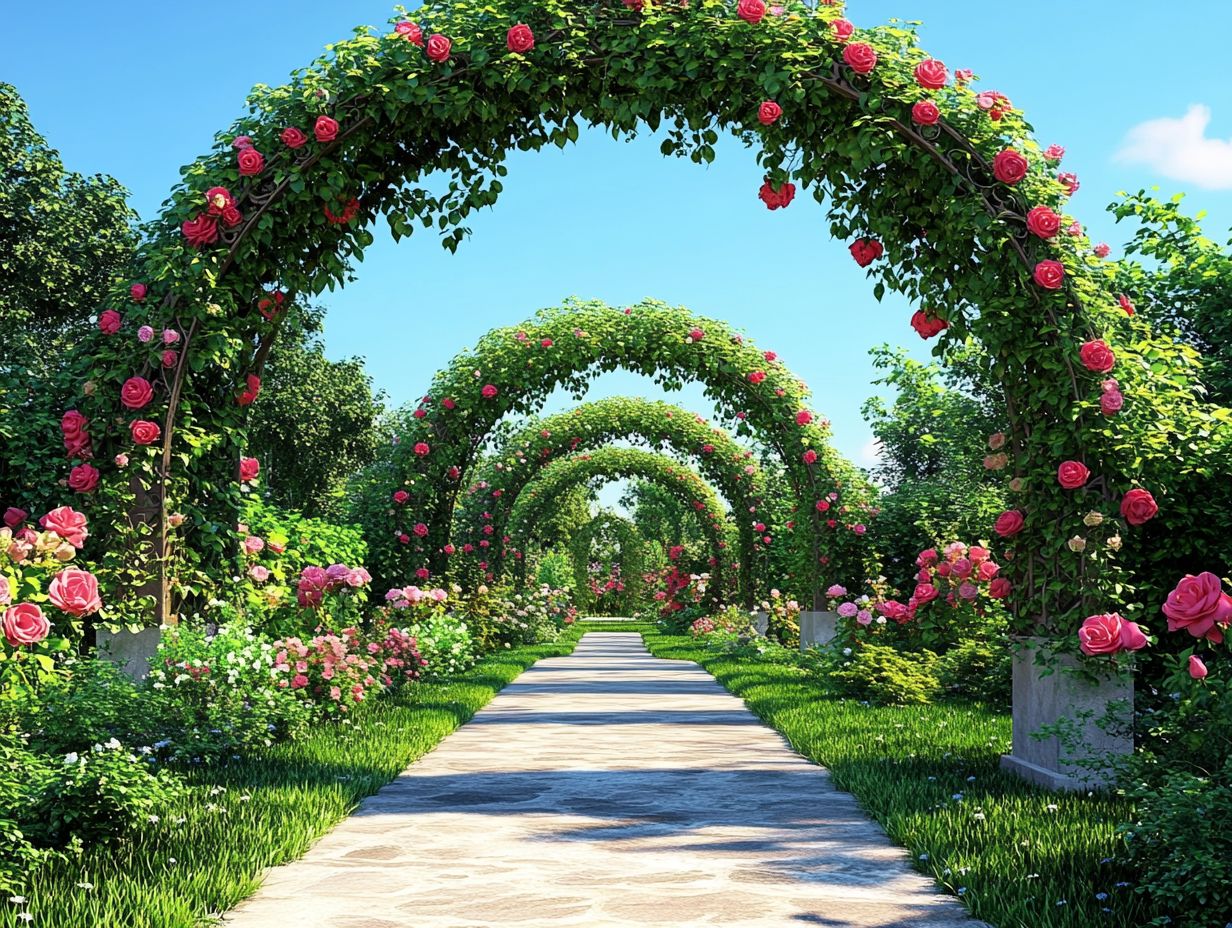
1. What are some popular styles of vintage garden arches, including arched and rustic designs?
Some popular styles of vintage garden arches include Gothic, Victorian, and Roman-inspired designs.
2. How can a vintage garden arch elevate my landscape by enhancing the beauty and creating a focal point for climbing plants?
A vintage garden arch can elevate your landscape by adding a touch of elegance and charm. It creates a focal point and provides support for climbing plants.
3. Are vintage garden arches durable, especially those made from metal or wood?
Yes, vintage garden arches are typically made from sturdy materials such as wrought iron or wood, making them durable and able to withstand outdoor elements.
4. Can I customize a vintage garden arch to fit my specific landscape with unique design options?
Absolutely! Many vintage garden arches come in different sizes, shapes, and colors, allowing you to choose one that best complements your landscape.
5. How do I care for a vintage garden arch to ensure its longevity and support for climbing plants?
To ensure the longevity of your vintage garden arch, it’s important to regularly clean and maintain it. This includes removing any debris or rust and applying a protective sealant.
6. Are vintage garden arches difficult to install, or can they be a fun DIY project for homeowners?
It depends on the type of arch and its size, but most vintage garden arches are designed to be relatively easy to install with basic tools and some assistance.
Don’t miss out on these incredible arch styles! Explore our collection of vintage arches today to enhance your garden!

